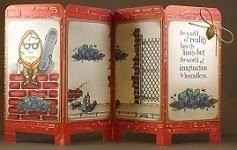The ability to produce 3-Tone Smooth Blending is likely the top reason that Copic markers have become so well-loved by Stampers. Stamped images can become more realistic and sometimes absolutely stunning with layers of smoothly blended shading. Layering various shades of color using these markers doesn’t cause the paper to pill or leave streaking in your images! Hooray for Copics!
But what if your images need streaking? Sometimes the most appropriate coloring for your image is spotty and streaky. If you use that beloved 3-Tone Smooth Blending, well then, your image may not look very realistic at all. Oh, it’s pretty and it looks nice. Then, sometimes it’s just too perfect and well, it becomes kind of unnatural-looking and perhaps even less interesting.
So let’s fix that! We’re going to add our very own 3-Tone Spots and Streaks. And, yes, we’re going to do it with the markers that have become highly sought after for their superior qualities meant to prevent streaks and spots. (Uh oh! The rebel is coming out in me. Some call it a poltergeist. Some call it “the other woman.” LOL!!!) Really, there are just some images that demand spotting and streaking for a more realistic and natural look. Ready? Let’s do this thing!
The first pumpkin image is filled using 3-Tone Smooth Blending. Looks nice, right? But it’s a whimsical pumpkin, and pumpkins have natural rib indentations that we can exaggerate by using streaks. The second pumpkin image now looks more natural and interesting. What do you think?
This open image of a wooden sign needs to look like a piece of wood. Select 3 Copic earth tone-colored markers. In the direction of the grain, fill the image using strokes of your lightest color. (You can use the brush or chisel tip of the marker.) Streak in some medium color lines (some thin, some thick). Lightly add the darkest color, still streaking in the direction of the grain. Add some of your lightest color back in between the grains. If you want your image to appear weathered, now streak in some gray. If you want your image to appear bleached, like a piece of dried driftwood, then now streak in some colorless blender. This sign has some natural highlights, shading, dimension and it looks more like a wooden sign than if it were smoothly blended. (Find out more about coloring things to look like wood at Marianne Walker's blog here.)
This stamped image of a bare tree branch needs some Spring blossoms. Select 3 Copic markers: a dark, medium and light color. Using the brush tip of your darkest color, create a 3-dot triangle at each limb’s end. Use the medium color to create a 3-dot triangle around each dark dot. Use the lightest color, wherever possible, to create a 3-dot triangle around each medium dot. Do you see how you’re building your blossom from the inside out? Remember that light pushes dark, so place a single dot of your lightest color over your darkest dotted areas. Finally use a coordinating atyou Spica to dot over your lightest areas to add some amazing sparkle. These Spring blossoms are not smoothly blended and they shouldn’t be. This image has some natural highlights, shading and dimension, even some glassy shimmer. It’s just right.
Try these techniques with other images. Give your naked winter tree images some summer leaves. Let your beachy wood pilings appear to be made of wood. Stamp your images of beach chairs, picnic tables, bushes, and hyacinths. Use your Copic markers to streak and stipple them. Compare them to images you’ve filled using 3-Tone Smooth Blending. Which images look more realistic to you? Let me know what you think.
Subscribe to:
Post Comments (Atom)














































































1 comment:
Great Job Rose, I still need some work getting the wood technique down, I know all will come in time. Also, love all the pictures, good clear and I like that you can click and enlarge them to get a closer look.
Talk to you soon.
Donna
Post a Comment